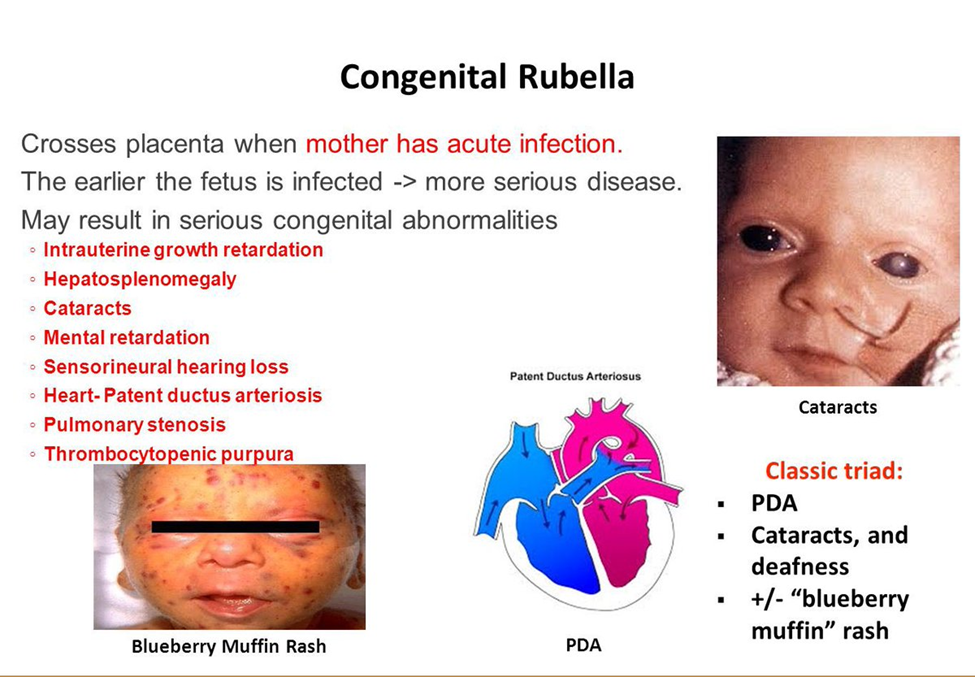Which common childhood communicable disease may cause severe defects in the fetus when it occurs in its congenital form?
Rubella
Varicella-zoster
Rubeola
Mumps
The Correct Answer is A
A. Rubella:
Rubella is a viral infection that, when contracted by a pregnant woman during the first trimester, can lead to congenital rubella syndrome (CRS) in the developing fetus. CRS can result in severe birth defects, including heart abnormalities, hearing impairments, and vision problems.
B. Varicella-zoster:
Varicella-zoster virus causes chickenpox. While chickenpox can cause complications in certain populations, it is not specifically associated with severe defects in the fetus when the mother is infected during pregnancy.
C. Rubeola:
Rubeola, commonly known as measles, can lead to complications, but it is not as strongly associated with severe defects in the fetus if the mother is infected during pregnancy compared to rubella.
D. Mumps:
Mumps is generally not associated with severe defects in the fetus when the mother is infected during pregnancy. However, mumps infection during pregnancy can pose risks to the mother's health.

Nursing Test Bank
Naxlex Comprehensive Predictor Exams
Related Questions
Correct Answer is D
Explanation
A. Approximately 18 lbs. 6 oz.:
This option represents an overestimation of the expected weight. Doubling the birth weight of 8 lbs. 2 oz. would be 16 lbs. 4 oz., so this choice is higher than the expected weight.
B. Approximately 14 lbs. 8 oz.:
This option represents an underestimation of the expected weight. Doubling the birth weight of 8 lbs. 2 oz. would be 16 lbs. 4 oz., so this choice is lower than the expected weight.
C. Approximately 24 lbs. 4 oz.:
This option represents a significant overestimation of the expected weight. Doubling the birth weight of 8 lbs. 2 oz. would be 16 lbs. 4 oz., so this choice is much higher than the expected weight.
D. Approximately 16 lbs. 4 oz.:
This option is the correct estimate based on doubling the birth weight of 8 lbs. 2 oz. It accurately reflects the expected weight of a 6-month-old child according to developmental milestones.
Correct Answer is B
Explanation
A. At 6 months, you need to quit breast-feeding because he is not getting enough iron or Vitamin C and D and that should help him transition to solids better:
This statement is incorrect. Breastfeeding is recommended for the first six months, and then complementary foods can be introduced while continuing breastfeeding. Breast milk is a primary source of nutrition, and iron and vitamins are typically supplemented as needed.
B. The first food offered to an infant is iron-enriched rice cereal and can be started now. Additionally, the infant needs to receive Vitamin D and iron:
This statement is accurate. Iron-enriched rice cereal is often recommended as a first solid food for infants, and vitamin D supplementation is commonly advised, especially for breastfed infants, as breast milk may not provide enough vitamin D.
C. If you give him one or two bottles of juice each day, he should get all the vitamins he needs. You can begin fruits and cereal in 1 month:
This statement is not recommended. Juice is not recommended for infants, especially in large quantities, as it can interfere with proper nutrition and contribute to dental issues. Also, introducing fruits and cereals should be done gradually, following appropriate guidelines.
D. You can begin feeding the infant fruits and vegetables now followed by iron-enriched cereal to ensure that he gets enough iron:
While introducing fruits and vegetables is a part of introducing solids, iron-enriched cereal is often recommended earlier as a source of iron. The recommendation for iron-enriched rice cereal aligns more with the typical guidance for introducing solids to infants.
Whether you are a student looking to ace your exams or a practicing nurse seeking to enhance your expertise , our nursing education contents will empower you with the confidence and competence to make a difference in the lives of patients and become a respected leader in the healthcare field.
Visit Naxlex, invest in your future and unlock endless possibilities with our unparalleled nursing education contents today
Report Wrong Answer on the Current Question
Do you disagree with the answer? If yes, what is your expected answer? Explain.
Kindly be descriptive with the issue you are facing.
